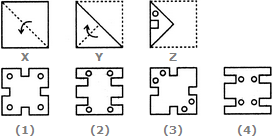Discussion
Home ‣ Non Verbal Reasoning ‣ Dot Situation See What Others Are Saying!
- Question
Select the figure which satisfies the same conditions of placement of the dots as in Figure-X.

Options- A. 1
- B. 2
- C. 3
- D. 4
- Correct Answer
- 3
ExplanationIn fig. (X), one of the dots lies in the region common to the square and the triangle and another dot lies in the region common to the circle and the triangle. In each of the alternatives (1), (2) and (4), the region common to the square and the triangle lies within the circle. Therefore, in each of these figures, there is no region common to the square and the triangle only. Only the alternative (3) consists of a region common to the square and the triangle only and another region common to the circle and the triangle only. Hence, fig. (3) is the answer. - 1. Choose the correct mirror image of the given figure (X) from amongst the four alternatives.
 (X) (1) (2) (3) (4)
(X) (1) (2) (3) (4)
Options- A. 1
- B. 2
- C. 3
- D. 4 Discuss
- 2. NA
Options- A. 1
- B. 2
- C. 3
- D. 4 Discuss
- 3. GLOBE
Options- A. .
- B. .
- C. .
- D. . Discuss
- 4. Group the given figures into three classes using each figure only once.

Options- A. 7,8,9 ; 2,4,3 ; 1,5,6
- B. 1,3,2 ; 4,5,7 ; 6,8,9
- C. 1,6,8 ; 3,4,7 ; 2,5,9
- D. 1,6,9 ; 3,4,7 ; 2,5,8 Discuss
- 5. Find the question mark
? figure from answer figure:

Options- A. 1
- B. 2
- C. 3
- D. 4 Discuss
- 6. Select a suitable figure from the Answer Figures that would replace the question mark (?).
Problem Figures: Answer Figures:
 (A) (B) (C) (D) (1) (2) (3) (4) (5)
(A) (B) (C) (D) (1) (2) (3) (4) (5)
Options- A. 1
- B. 2
- C. 3
- D. 4
- E. 5 Discuss
- 7. Select a suitable figure from the Answer Figures that would replace the question mark (?).
Problem Figures: Answer Figures:
 (A) (B) (C) (D) (1) (2) (3) (4) (5)
(A) (B) (C) (D) (1) (2) (3) (4) (5)
Options- A. 1
- B. 2
- C. 3
- D. 4
- E. 5 Discuss
- 8. Choose a figure which would most closely resemble the unfolded form of Figure (Z).

Options- A. 1
- B. 2
- C. 3
- D. 4 Discuss
- 9. Find the question mark ? figure from answer figure.
Options- A. 1
- B. 2
- C. 3
- D. 4 Discuss
- 10. NA
Options- A. 1
- B. 2
- C. 3
- D. 4 Discuss
More questions
Correct Answer: 4
Correct Answer: 2
Explanation:
NA
Correct Answer: .
Explanation:
Answer A
Correct Answer: 1,6,9 ; 3,4,7 ; 2,5,8
Explanation:
1, 6, 9, are all triangles.
3, 4, 7 are all four-sided figures.
2, 5, 8 are all five-sided figures.
Correct Answer: 2
Explanation:
From first figure to second figure the diagonals are deleted and both the dots are arranged vertically.
Correct Answer: 1
Explanation:
The symbols move in the sequence
 . Also, the arrow rotates 135
oACW; the trapezium gets vertically inverted and the pin-shaped symbol rotates 90
oCW.
. Also, the arrow rotates 135
oACW; the trapezium gets vertically inverted and the pin-shaped symbol rotates 90
oCW.
 . Also, the arrow rotates 135
oACW; the trapezium gets vertically inverted and the pin-shaped symbol rotates 90
oCW.
. Also, the arrow rotates 135
oACW; the trapezium gets vertically inverted and the pin-shaped symbol rotates 90
oCW.
Correct Answer: 2
Explanation:
The upper element rotates through 180
o and its head gets inverted. The lower element gets vertically inverted.
Correct Answer: 3
Correct Answer: 4
Explanation:
The first figure is bigger in each unit.
Correct Answer: 4
Explanation:
NA
Comments
There are no comments.Programming
Copyright ©CuriousTab. All rights reserved.
